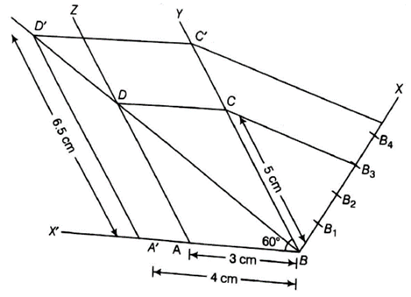Draw a parallelogram ABCD in which BC=5 cm, AB=3 cm, and ∠ABC=60°, divide it into triangles BCD and ABD by the diagonal BD. Construct the triangles BD’C’ similar to ∆BDC with scale factor 4/3. Draw the line segment D’A’ parallel to DA, where A’ lies on extended side BA. Is A’BC’D’ a parallelogram?
Steps of construction
1. Draw a line AB=3 cm.
2. Draw a ray BY making an acute ∠ABY=60°.
3. With B as center and radius equal to 5 cm draw an arc cut the point C on BY.
4. Draw a ray AZ making an acute ∠ZAX’=60°.(BY││AZ, ∴ ∠YBX’=ZAX’=60°)
5. With A as center and radius equal to 5 cm draw an arc cut the point D on AZ.
6. Join CD and finally make a parallelogram ABCD.
7. Join BD, which is a diagonal of parallelogram ABCD.
8. Draw any ray BX downwards making an acute ∠CBX.
9. Locate 4 points B1,B2,B3,B4 on BX, such that BB1=B1B2=B2B3=B3B4.
10. Join B4C and from B3C draw a line B4C’||B3C intersecting the extended line segment BC at C’.
11. Draw C’D’![]() CD intersecting the extended line segment BD at D’. Then, ∆D’BC’ is the required triangle whose sides are 4/3 of the corresponding sides of ∆DBC.
CD intersecting the extended line segment BD at D’. Then, ∆D’BC’ is the required triangle whose sides are 4/3 of the corresponding sides of ∆DBC.
12. Now draw a line segment D’A’![]() DA, where A’ lies on the extended side BA
DA, where A’ lies on the extended side BA
13. Finally, we observe that A’BC’D’ is a parallelogram in which A’D’=6.5 cm A’B = 4 cm and ∠A’BD’= 60° divide it into triangles BC’D’ and A’BD’ by the diagonal BD’.
